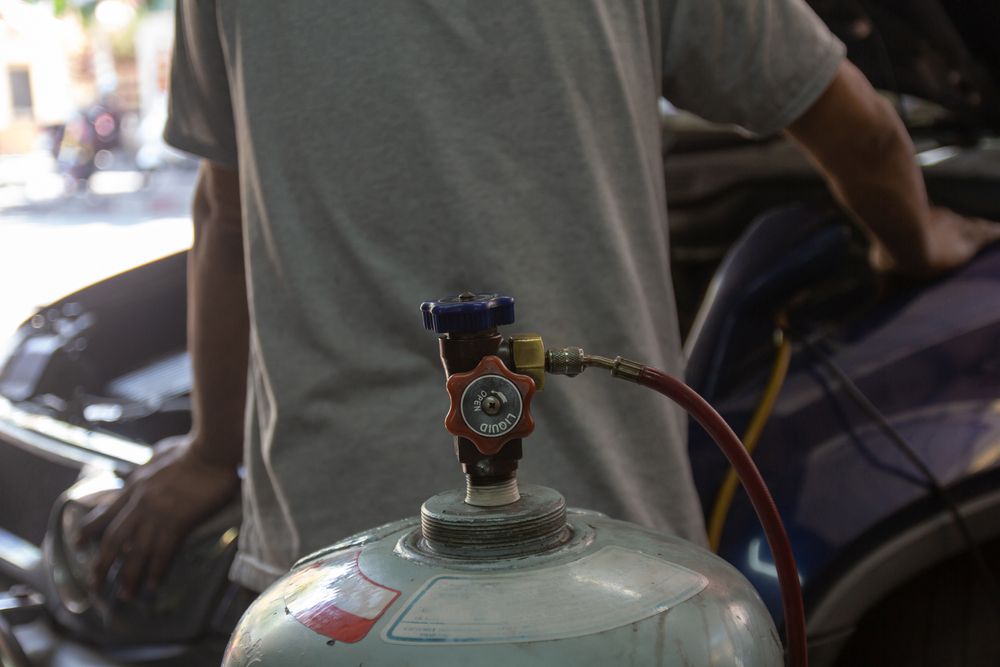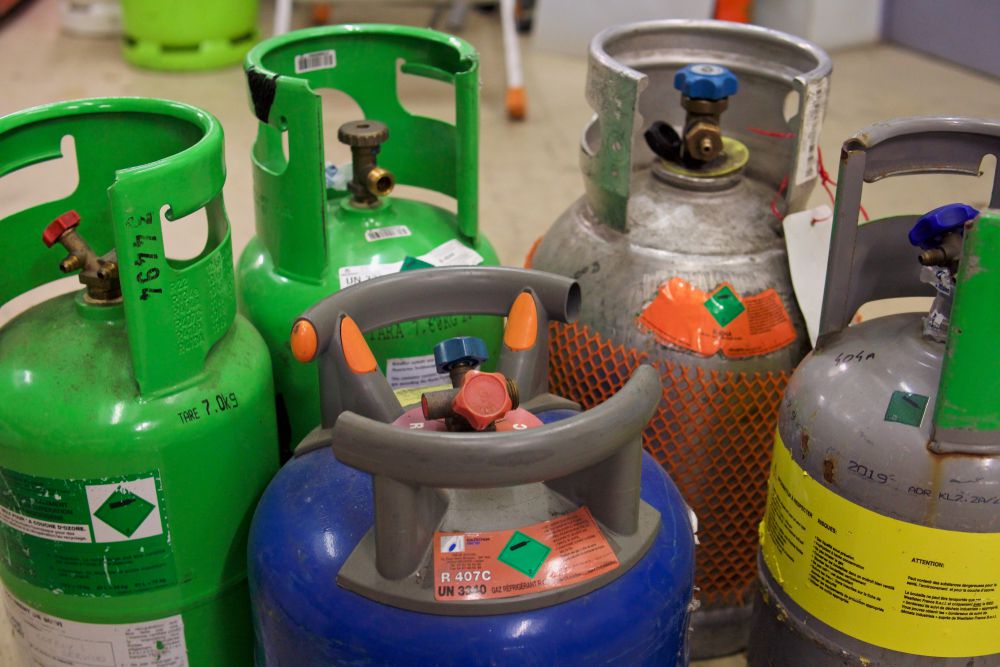If you have started noticing that your car's air conditioner isn't blowing
cold air like it usually should, then it may be time to check your car's
Freon level. Thankfully, this is a pretty simple process that doesn't take
very long to do.
You can check the Freon level in your car by using a pressure gauge that
attaches to the low pressure service port for your car air conditioning
system. You can also check the Freon level by using a vent thermometer to
check the temperature in your ac vents.
Use this guide to help you out, and hopefully you won't have to suffer
through any more hot summer days with no cold air in your car.
 A mechanic recharging a car with freon.
A mechanic recharging a car with freon.
How Can You Tell If Your Car Is Low On Freon?
Your car's air conditioning system has to have a certain amount of
refrigerant to operate correctly.
There are a few ways you can tell if the R-134A or Freon level is too low
for your car's AC to keep blowing cold air.
1. Car Air Conditioner Is Blowing Cool Air Instead Of Cold Air
The most obvious way to tell that you may have low Freon is that your car's
air conditioner is only blowing cool air instead of cold air.
If your car's Freon level is low, then the air conditioner can't cool the
air in your car like it's supposed to.
If the air coming from your vents doesn't feel as cold as it should, this
is definitely a sign that your refrigerant level is too low.
2. Car Air Conditioner is Blowing Warm Air
If your car air conditioner is blowing warm air, this is another way to
tell that your car is low on Freon.
In the middle of wintertime, you want your car's AC blowing warm air.
However, in the summertime, warm air is the last thing you want. This can
create a very uncomfortable problem.
Usually, warm air is a sign that your refrigerant level is very low. Your
car air conditioning unit is a type of heat exchanger, so removing heat
from the air is part of how it functions.
Once it loses its ability to cool the air in your cabin, you will notice
warm air blowing from your vents.
As a side note, if your air conditioner is blowing hot air, this may be a
sign of a different problem that doesn't involve low Freon.
Hot air comes from a different compartment in your vents. There is a small
flap, called a blend door, in between the warm air and cold air
compartments that controls which side the air blows from.
If this blend door stops working or gets stuck in the wrong position, it
can cause the wrong temperature air to blow through your vents.
 A mechanic hooking up his AC servicing machine to a customer.
A mechanic hooking up his AC servicing machine to a customer.
3. Visible Refrigerant Leaks Around AC Lines
Visible refrigerant leaks are another sign that your Freon levels may be
low.
If you inspect your AC lines and notice a greasy or oily film leaking from
any of them, this is evidence of a refrigerant leak. The exact location of
the leak can be traced by finding where this oily film is most
concentrated.
This kind of leak can be a serious problem and can lead to damage to your
car's AC unit.
Since your car air conditioning is under pressure, it has to stay in a
closed system to work properly. Any refrigerant leak will cause low
pressure in your system.
You will definitely need a Freon recharge if you find any visible
refrigerant leaks, but you need to find the cause of the leak and have it
repaired to truly fix the problem.
4. AC Clutch Doesn't Engage Correctly
The AC compressor uses a clutch that allows it to engage with the drive
belt on the engine. If your air conditioning has low Freon, the clutch will
not engage like it's supposed to.
The clutch has a sensor called a cycling switch that detects the ambient
temperature and the pressure of the Freon in your air conditioning system.
If your system doesn't have enough Freon, then the switch will keep your
compressor from engaging like it's supposed to.
You can hear a click from your engine when the compressor clutch engages.
If you don't hear this click a few minutes after you start your engine, you
may not have enough refrigerant for it to work right.
How To Check Freon Level In Car Without Gauge?
If you don't have a gauge to check your car's Freon level, you can use a
vent thermometer instead.
Most large auto parts stores sell a special type of thermometer that is
inserted in your air conditioning vent to read the air temperature.
This type of thermometer will give the most accurate reading, but you can
also use a digital laser thermometer instead.
To measure your air temperature, do the following:
-
Insert the vent thermometer in your center air conditioning vent.
-
Start your car.
-
Turn on your air conditioner to the coldest temperature setting,
with the fan speed as high as it will go.
-
Make sure your recirculation air switch is on.
-
Close all doors and windows.
-
Let your car run for at least 10 minutes.
-
After 10 minutes, check your vent thermometer. (If you use a
digital laser thermometer, take your reading with it now.)
Your thermometer should have a temperature reading of between 40 and 50
degrees Fahrenheit, depending on the ambient temperature.
If the temperature reading is any higher, then your car may have low Freon.
How Do You Know If Your Car AC Needs Recharged?
Your car's air conditioner needs to have a certain amount of Freon or
R-134A in order to provide cool air.
You can use a special gauge to measure the level of refrigerant charge in
your AC unit.
Locate the service ports on your AC lines, in your engine compartment.
There will be a low pressure port and a high pressure port.
You can measure from just the low pressure side, but it's best to measure
from both service ports.
Your engine must be running, with the car AC turned on to max cool, to
properly measure your refrigerant level. Attach the gauges to both service
ports and take a reading.
If the Freon level at your service ports measures between 30 and 40 PSI on
the low pressure service port, and between 150 and 200 PSI on the high
pressure service port, this is the correct reading.
Your gauge may also have a color indicator to show the correct level. As
long as your needle is in the green range on your gauge, your system has
the correct amount of refrigerant.
If your reading is too low, then your vehicle's air conditioning system
needs to be recharged.
If your temperature reading on your vent thermometer is too high, it can
also be a sign that you are in need of a Freon recharge.
 Driving a car with malfunction AC can be very uncomfortable.
Driving a car with malfunction AC can be very uncomfortable.
How Often Do Cars Need Freon?
Although a car air conditioning system is closed, the freon levels will slowly decrease over time due to molecular leaks.
You can ideally expect for your car AC system to hold a Freon charge for
around 3 to 5 years if it is running normally with no refrigerant leak.
You should check for low Freon once every year or 2 during routine
maintenance. If you live in a hotter climate, checking it more often is a
good idea.
Can I Put Freon In My Car Myself?
Yes, you can add more Freon to your car's air conditioner yourself.
However, you should make sure you understand the process before you attempt
it. Overcharging your AC compressor with too much refrigerant can cause
permanent damage to your air conditioning system.
If you decide you want to recharge your AC, all you need is a can of
whatever type of refrigerant that the air conditioner of your car model
uses and a dispenser hose with a gauge.
Most auto parts stores will sell these together as a complete kit, and you
can reuse the charging hose after you have emptied the can of refrigerant.
Here are the steps to add more Freon:
-
Make sure to wear protective gloves and safety goggles. This is a
pressurized system that can be dangerous.
-
Locate the low pressure service port on the passenger side of your
engine bay. Remove the cap and wipe the port clean.
-
Start your engine and set your air conditioning to max cool, or the
lowest temperature setting with high fan speed.
-
Attach the refrigerant and charging hose to the low pressure
service port.
-
Using the instructions on your refill kit, add Freon to the system.
-
Do not add more Freon than is needed for your AC system. Your gauge
will show you when the system is at the correct level.
-
Your AC clutch should engage and stay engaged through the
compressor cycle if the Freon level is correct.
One thing to note is that you should not attempt to recharge your car's air
conditioning system if the outside temperature is below 55 degrees
Fahrenheit.
Cold temperatures can affect the reading on your test gauge, and can cause
you to accidentally add too much Freon to your system.
 Containers filled with freon.
Containers filled with freon.
What Is Freon?
The term Freon has become a "catch-all" phrase to describe any kind of air
conditioner refrigerant.
The actual Freon refrigerant is a name brand product of DuPont Chemical
that was developed in 1930. This type of refrigerant was made from a
chemical called dichlorodifluoromethane, and was known by its trade name
R-12 (or CFC-12.)
This chemical is a type of CFC (chlorofluorocarbon) which has been proven
to be destructive to the Earth's atmosphere.
Because of this, the use of Freon or R-12 refrigerant was phased out
beginning in 1987. It was almost completely out of use by 1994.
Freon was replaced by the newer R-134A refrigerant. This is what most air
conditioning systems now use in vehicles made after 1994.
R-134A refrigerant is made from a chemical called tetrafluoroethane, which
is more environmentally friendly.
Will Low Freon Damage A Compressor?
Low Freon levels can definitely be responsible for damage to your AC
compressor.
The Freon in your AC compressor fluctuates between a gas and liquid
refrigerant, which allows it to absorb and release heat as it is naturally
intended to do.
When the Freon levels get too low, your AC compressor can't function
correctly. This puts more strain on the entire system, which can lead to
premature wear and failure.
Also, having low Freon levels will allow liquid moisture to build up in
your air conditioning system. This moisture will lead to ice forming
because it can't get hot enough to evaporate.
The freezing moisture can lead to damage to the components of your AC
system.
How Much Does It Cost To Fill Freon In Car?
The cost to recharge your AC system depends on whether you decide to do it
yourself or have it done by a mechanic.
Typically, you can expect to pay between $150 and $300 to have a mechanic
recharge your car's air conditioning. This price covers the Freon cost as
well as the labor cost involved in having the work done by a professional.
You can save money if you decide to recharge your air conditioner yourself.
A kit that includes a can of R-134A refrigerant and a charging hose and
gauge assembly usually costs around $30 to $50 at most auto parts stores.
For most vehicles, one can of R-134A will last long enough to provide
several recharges.
There can be peace of mind in paying a professional to do a Freon recharge
for you. You know the work will be done correctly without the risk of
damaging your air conditioner.
However, if you don't want to spend the money to hire a mechanic, this is an easy enough job, shouldn't take too much time, and keep some of that money in your pocket.
Conclusion
Car air conditioning is a great part of modern life, but it can cause a big
headache if it doesn't work right.
If you think you may have low Freon in your vehicle, you can use this guide
to figure out what your problem may be.